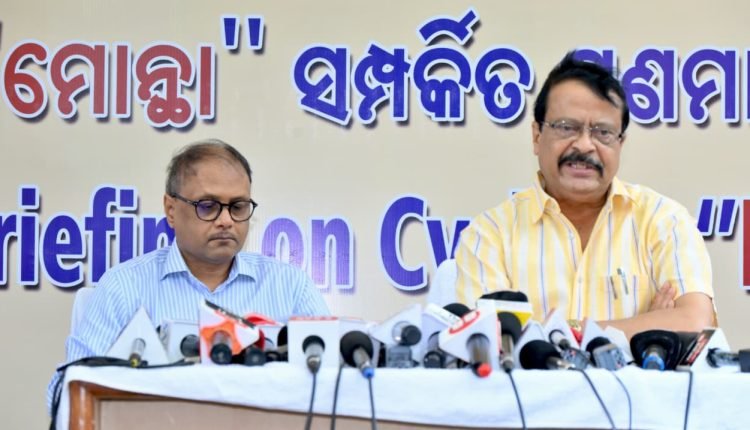Post-Cyclone Montha Situation Reviewed by Revenue and Disaster Management Minister Suresh Pujari
Odisha’s proactive disaster preparedness, inter-departmental coordination, and timely evacuation efforts ensured minimal damage as Cyclone Montha changed course at the last moment.
A high-level review meeting on the post-cyclone situation was held today under the chairmanship of Revenue and Disaster Management Minister Shri Suresh Pujari. The meeting was attended by Special Relief Commissioner (SRC) Shri Deoranjan Kumar Singh and other senior officials, who discussed various aspects of post-cyclone restoration and relief measures.
Government’s Timely Preparedness Paid Off
Addressing media representatives after the meeting, Minister Pujari recalled that on this very day in 1999 (October 29), the Super Cyclone had devastated Odisha, causing massive loss of life and property. However, this time, the government’s proactive preparedness and effective coordination among departments helped avert major damage during Cyclone Montha.
He said that based on the India Meteorological Department’s early forecasts, the state government launched a comprehensive pre-cyclone preparedness drive, ensuring that all departments—from district to grassroots levels—were ready to tackle any emergency. He also appreciated the role of the media in creating public awareness and helping people stay alert.
“Fortunately, although the public was anxious, the cyclone changed its course at the last moment, sparing Odisha from severe impact,” Pujari said.
Multi-Agency Deployment
For effective disaster response, a total of 161 teams were deployed, including 33 ODRAF teams, 5 NDRF units, and 133 fire service teams.
A total of 2,164 cyclone and flood shelters were identified, and 18,732 people were safely evacuated and provided with all necessary facilities.
In addition, 2,198 pregnant women were shifted to nearby health centres and maternity homes, where many have since delivered safely.
Medical and Veterinary Support
To ensure health safety, 60 medical teams were deployed across potentially affected regions. For the protection of livestock, 35 veterinary teams were also on duty. The cyclone affected 33 blocks, 11 urban areas, and 358 villages, while 362 community kitchens served cooked food to 18,732 evacuees.
Restoration of Power and Road Connectivity
The Energy Department ensured uninterrupted power supply during the storm, with rapid restoration in areas that experienced disruption. Fallen trees blocking roads were immediately cleared to restore normal traffic movement.
“Normalcy is expected to be fully restored by October 31, and damage assessment will begin from October 30, following which necessary government assistance will be provided to the affected,” the Minister assured.
Heavy Rainfall Recorded in Southern Districts
During the past 24 hours, Gosani block of Gajapati district recorded the highest rainfall of 150.5 mm. Other areas with over 100 mm of rainfall include Rayagada (119.8 mm), Mohana (106 mm), Patrapur in Ganjam (117.4 mm), and Udala in Mayurbhanj (105 mm). Additionally, 56 other blocks and urban areas recorded rainfall between 50 mm and 100 mm.
Effective Coordination Averted Major Loss
SRC Shri D.K. Singh noted that the government had started its pre-cyclone planning and coordination well in advance, with regular meetings involving Collectors and department Secretaries. “Due to this coordinated approach, the state successfully prevented loss of life and major property damage,” he stated.



Comments are closed.